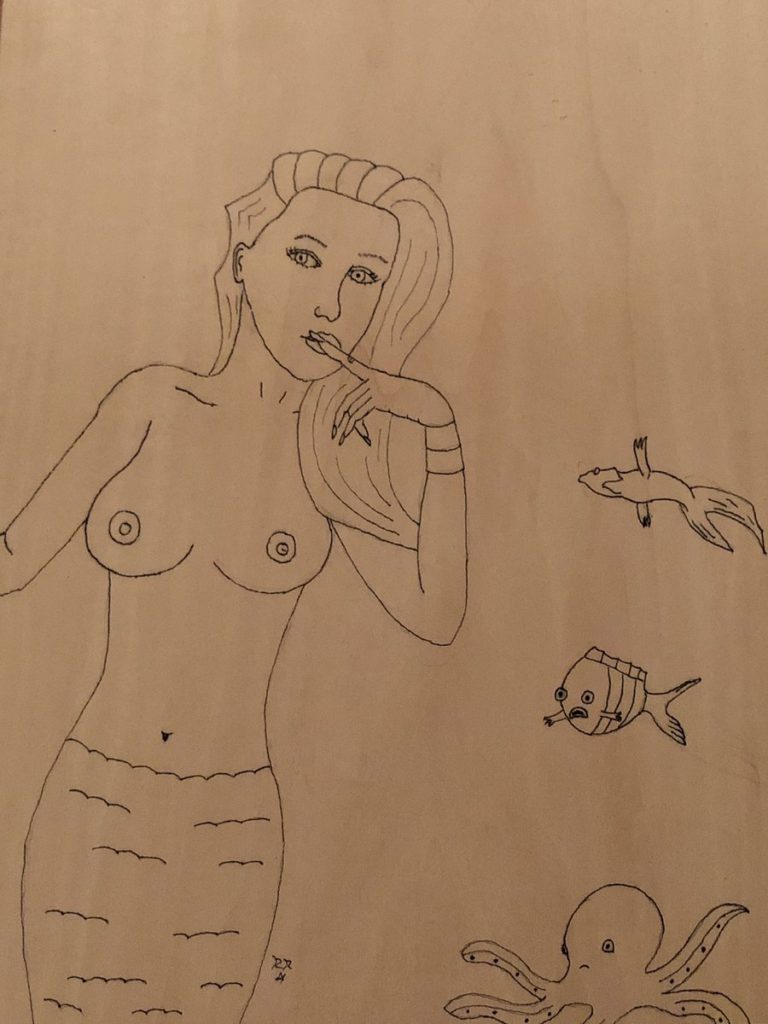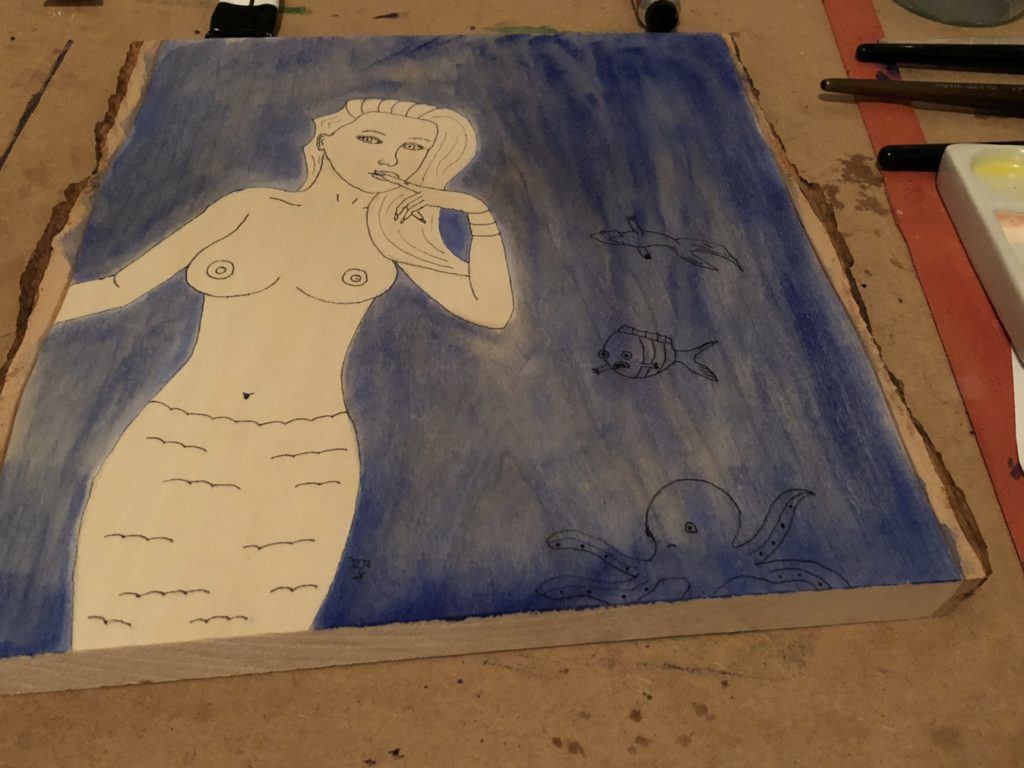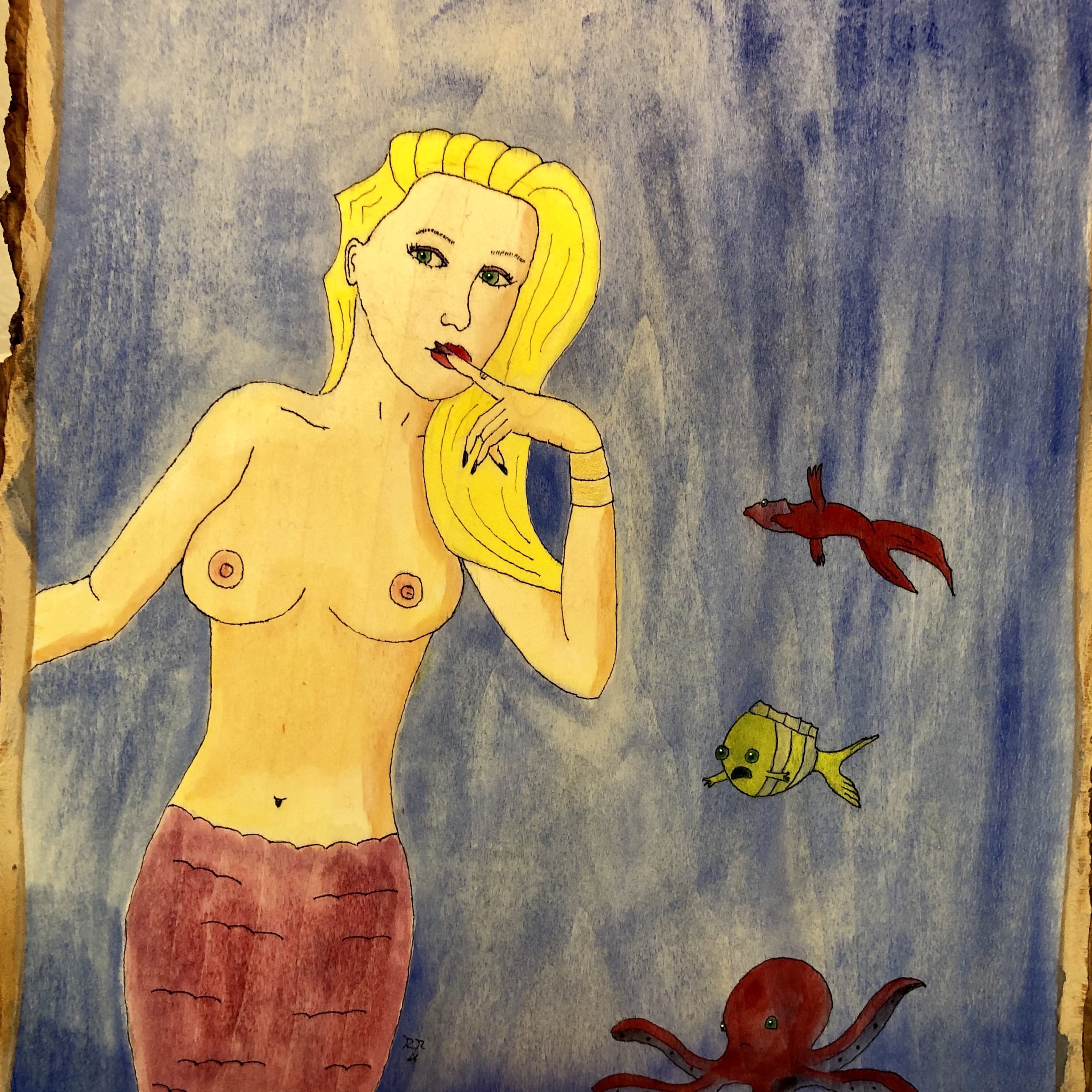Watercolor on wood. It just sounds cool. However, if you don’t know what you’re doing, it will end up a disaster.
I’m assuming you’ve already painted watercolor on watercolor paper (which is made from acid-free cotton, not regular paper). If you haven’t, watercolor paper is what most watercolor artists paint on most of the time.
Some of us love to experiment on different surfaces for whatever reason. I’m one of those people.
I’ve now painted on watercolor paper, clay (a product called Aquabord), and wood. I won’t go into clay in this article. But I will give you some differences between watercolor on wood and watercolor on watercolor paper.
Watercolor on paper
This is your generic watercolor painting. I don’t want to spend too much time on this because I assume you’ve done this many, many times. This article is written for people who have already painted on paper and want to experiment on wood. But if you’re wondering what to start out on, I’ll give you a few paragraphs.
Watercolor on paper is as generic as it gets. Good paper absorbs washes beautifully. It also takes in your colors as you expect them to.
I always paint with a blank piece of copy paper on my right side and when I mix colors, I try them out first on the copy paper. Those colors will be very close to what you’ll see on the watercolor paper. Not exact, but close enough.
You’ll also get used to drying times. You have to wait until one layer is dry before moving onto the next layer. You’ll need to know terms like “wet on wet” and “wet on dry” at the very least to be a decent watercolor artist. You’ll be using both.
Watercolor on wood
Now, this is where it gets tricky. Assuming you’re used to painting on watercolor paper, wood is, well, weird.
Bleeding
Wood bleeds a lot. Not every watercolor artist inks. However, I always ink. If you use ink, keep in mind that wood really bleeds a lot. You’ll want to use a thinner ink pen/brush. Here, I’m using a Pigma Micron 005, which is very thin.

You can’t ink too slowly or else it will bleed all over the place. You’ll need to get confident with your lines.
After you’ve inked, keep in mind that watercolor bleeds with paint as well. Whereas with paper, you can make mistakes, you can’t make mistakes with wood. Good luck trying to get your mistake out. The paint will bleed into where you don’t want it to bleed, then stain. You’re more than likely not going to be able to cover up that stain.
To anticipate the bleeding, you’ll need to know which way the wood flows. Look closely at the lines in the wood. Know them well.
Also, know exactly how wet your brush is. The more wet, the more bleed. For fine details and edges, you almost want to dry brush.
Sucks paint
Is the price of paint an issue for you? I’m not saying this to be an asshole. I’m saying this to be a realist. If you’re broke, keep in mind that you’re going to go through a lot of paint. You simply need more paint than you will with paper.

You see that blue for the water? That was a shitload of paint. That’s enough paint for at least three or four watercolor paper paintings. No, I’m not exaggerating.
Light colors don’t show
You’ve more than likely learned the rule to never, ever go dark to light. You always want to paint light to dark. Right?
Well, that is correct for paper. However for watercolor on wood, it’s different.
Allie has light skin. When I first painted her skin color, it didn’t show up at all. This was exactly the same paint I just mixed for my previous painting on paper.
So, I did a cardinal sin. I mixed a darker paint, then went dark to light.
It worked perfectly. Whereas you never, ever want to do this on paper, you may have to do this on wood for the lighter colors.
Yes, the darker colors will show through as watercolor paint is very transparent. However, do you want the darker colors to show through versus having nothing show up at all? I’ll take the former.
Wet on wet
Here’s where it gets weird. You’re used to painting wet on wet and everything working well on paper. Well guess what? On wood, your water just got sucked into the wood. You’re going to need more water.
But then, if you use too much water, your paint will bleed all over the place and ruin your painting. But if you don’t use enough water, your wet on wet won’t be a wet on wet.
Heh. Catch 22. Good luck with this.
OK, I won’t be an asshole about it.
You need to do this carefully. Wet on wet still works with wood. You just need to figure you’ll need more water, but you have to be very careful about bleed.
Waiting for the paint to dry to paint the next layer
This is one thing I absolutely love about wood. Whereas it doesn’t per se dry faster. In reality, it sucks the paint so you can paint the next layer sooner. You save time painting on wood.
Also, layering looks really cool when you do this. The wood isn’t necessarily dry, but the previous paint layer has been sucked in enough that you can put the next paint layer over it.
I can’t speak for you, but I’m a classic Type A person. I’m extremely impatient. I have to be doing something at all times.
This is one of the reason I love painting on wood. Some folks use hair dryers to speed things up. I don’t own a hair dryer, so in between layers on watercolor paper, I go play my guitar.
For wood though, the wait is very short. For paper, I wait an hour between layers. Watercolor on wood though, I wait about ten minutes. Yes, it’s that fast between layers.
Do not make mistakes
I said this before but it needs repeating. Do not make mistakes when painting on wood.
You can pretty much fix most mistakes when painting on paper. On wood though, good luck. Bleed is harder to cover up and wood is unforgiving for mistakes. They’ll be noticeable.
I’d only recommend wood for someone who’s confident in their ink and their brush strokes.
A few more notes
I love drawing on wood. It looks really cool. I need to say this again because it’s really, really important. Watercolor on wood looks really cool! (Isn’t that why artists do anything anyways?)
I pencil before I ink. The pencil erases similarly to paper. Actually, it erases better than a lot of watercolor papers.
Wood being not white though, you’ll have to look more closely at the pencil. It hides more with the coloring of the wood. That often means either penciling with more force or penciling more than once.
Once I got the ink down though, the ink busts through. It looks great.
The other thing is some wood requires sanding. All wood requires cleaning. Before painting, clean your surface with a moist cloth before you even start drawing on it.
And lastly, I mentioned that for watercolor on paper, I test the colors with a piece of copy paper first. You’re simply not going to get the same colors on wood that you will get on paper. Colors look different on wood. If you’re a color purist, you might want to stick to paper.
Conceptually, it feels more like you’re staining the wood than painting. You’ll know what I mean when you start painting on wood.
Preserving your piece
When you’re finished, it’s going to look different than watercolor paper. You can still see the wood. Which I absolutely love about it.
I use a real thick coat of varnish spray. I let it dry overnight, then I put two generous layers of wax finish over it. Between the varnish spray and the wash, your watercolor on wood painting should last hundreds of years if taken care of.


I’m new at this but I started with a coat of watercolor ground. I haven’t painted it yet, I’m nervous! But it says you can coat any surface and then use watercolor. It does have to dry 48 hrs. 😏
Nice!
Note that if you put watercolor ground over the wood, you’ll cover up some of the wood’s lines. So you have to decide how much of the wood you want to show. More coats of ground, less wood shows.
The example I used above was with no watercolor ground. Just straight onto the wood.